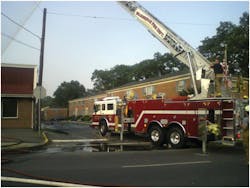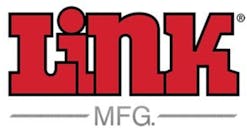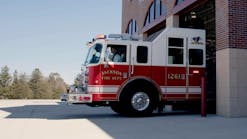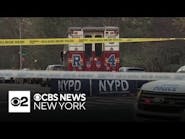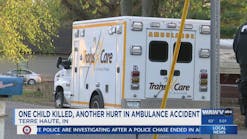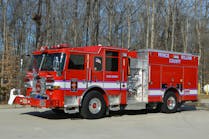The success of the first-arriving truck company is contingent on a number of factors: they should be properly equipped, well trained, adequately staffed and respond using the safest and most efficient path of travel from the station to the incident scene. From there, the initial spotting of the apparatus is a critical point in the company’s capabilities to carry out the four primary truck company functions upon arrival: primary search, rescue, ventilation and forcible entry. Allowing the proper access to the best vantage point for the truck will assist in these functions.
Why Placement Matters
It is a common belief (and rightfully so) that the front of the address/incident belongs to the first-due truck company, barring no structural collapse issues regarding this location (see Photo 1). If so, it will be necessary to flank the corner of the building to stay clear of the collapse zone. Furthering this belief, it is critical that the initial response must take into consideration the immediate coverage of both the front and the rear of the building. Fire conditions can vary greatly from the front to the back, and the use of the aerial device may be more significant around the rear of the building. The sides of the building still must be addressed, as immediate action may be necessary there as well. Therefore, the first arriving Truck Company should be assigned the front of the building as long as the apparatus can make a significant impact on the conditions of the incident.
Consider the response to a residential structure fire in a two-story wood-frame dwelling with fire showing on the second floor. The first-due truck company would be required to cover the second floor for search and rescue, and get to the roof to stand by for ventilation operations and report conditions to the incident commander (IC). In many residential settings, homes are set back a considerable distance, sometimes more than 75 feet back from the street. The 75-foot aerial that is arriving first may not be the best choice to cover the front, due to its limited reach to accomplish the company’s objectives.
Although the second-arriving truck company is assigned to cover the rear of the building, that does not necessarily mean that the apparatus must position at the rear; in most cases, that may be impossible to do. What it does require is that the company members get to the rear of the building and report the situation to the IC, looking for signs of possible victims, location and extent of the fire, force entry into the rear of the building as a second means of access/egress, and report any additional hazards that exist at the rear of the building (see Photo 2).
In addition, locations of exposures, power supplies, rear stairways, porches, and basement and cellar entrances can be identified, and command can be advised if an additional engine company is needed around the rear of the building. Truck companies can also spot ladders to the upper floors and report their locations to crews working inside the structure in the event they need to exit the upper floors in an emergency.
Aerial Positioning
To be effective, the truck company must position the apparatus on the fireground to accomplish the tasks assigned based upon order of arrival. Before committing to a specific position, consider the following points:
- Keep in mind the needs of other apparatus at the incident; keep a lane of traffic open for additional responding apparatus, EMS units, utility companies, etc.
- Allow enough room for the engine company to get close enough to the building to operate (see Photo 3).
- Check for overhead issues (wires, branches, or any other problems with spotting). Many times the truck officer should step out prior to arrival and identify the best spot for the apparatus to operate from (see Photo 4).
- Make sure the area in question can support the apparatus when the aerial is operating.
- Check the angle! The apparatus must be positioned for safe and efficient operation to perform the tasks assigned and to provide maximum scrub (the total area that can be covered or reached by the aerial device) to the face of the building.
- Consider the need to relocate – if things start to go bad, how rapidly can you break down and get out? It is wise to consider this point prior to committing to aerial operations.
- Access to the roof may require the aerial to pick a spot on an adjoining building for crews to access the roof; be sure of where you are operating before your operator sets the jacks.
- The rear of the apparatus should be angled off of the curb line a minimum of 25 degrees. This will allow ladders and other equipment in the rear compartments to be retrieved in the event an arriving company parks too close to the rear of the truck company. A typical standing order for many Truck Companies is to make sure that no one parks within 25 feet of the rear of the apparatus.
Placement for Tasks
Upon arrival, the arriving truck companies should announce their assignment so that next-arriving companies can either cover other sides of the building, stage uncommitted until ordered, or follow the department’s protocol for the arriving apparatus. In the event that truck companies are arriving uncommitted, it is easier to stage them on respective side streets of the actual incident for a few reasons; it can be difficult to re-position an aerial apparatus after it is in position, and being on a cross street can allow the company to cover the rear and sides of the fire building easier.
When positioning, the point of the apparatus to “spot” on-scene is the turntable. In order for the truck to be efficient and effective on-scene, the turntable must be in a position so that the turntable and the bedded device have the best clear shot at the building. While the overhead wires are a hazard, utility poles on narrow streets can hamper the operation of the aerial; narrow streets and close proximity to these poles can limit the aerial to come out of the bed and into operation. Additionally, remember that where the apparatus is positioned has a direct effect on the scrub area. Certain types of apparatus have larger scrub areas than others, but as a rule of thumb, the larger the working height of the device, the more scrub area the device can cover. Officers must consider access, egress, platform operations for rescue and elevated stream operations when positioning (see Photo 5).
Consider street conditions for positioning; a narrow street may put the apparatus too close to the fire building, limiting the useful scrub area because it will limit the swing and boom operations of the apparatus. Being too far away will result in a limited area that the end of the device can cover. Keep in mind the length of the bedded section of the aerial of the telescopic boom; this is usually the longest part of the device, and as long as the apparatus is spotted in a position that allows the bedded length of the apparatus to move freely into position, the placement is suitable for most operations.
Conclusion
Truck company placement for initial operations is of paramount importance to the success of the incident. Being able to position the apparatus to assist in completing the Company’s initial primary tasks adds coordination and safety to the fire attack, and can benefit both the department and the public that they serve in reducing injuries and losses due to fire. Be sure to set up your apparatus in various locations in your response area so everyone knows the capabilities and limitations that the Truck Company may have upon arrival.
Until next time, stay focused and stay safe.
MICHAEL P. DALEY is a lieutenant and training officer with the Monroe Township, NJ, Fire District No. 3, and is an instructor with the Middlesex County Fire Academy, where he is responsible for rescue training curriculum development. Mike has an extensive background in fire service operations and holds degrees in business management and public safety administration. Mike serves as a rescue officer with the New Jersey Urban Search and Rescue Task Force 1 and is a managing member for Fire Service Performance Concepts, a consultant group that provides assistance and support to fire departments with their training programs and course development. You can reach Michael by e-mail at: [email protected].
